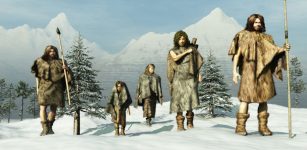The Burnt City And Its Mysterious Prehistoric Inhabitants
MessageToEagle.com – Once the Burnt City, (original name: Shahr-e-Sookhteh) was the largest prehistoric city of Iran. Its inhabitants were of unknown origin.
A true mystery surrounds the Burnt City located in the southeast province of Sistan and Baluchistan, bordering Pakistan and Afghanistan and spanning over a 300,000 hectare area.
This ancient place – one of the vital centers of Asian civilization in the Bronze Age – was an important converging point of such impressive prehistoric civilizations as Persia, Mesopotamia, India, and China in prehistoric times.
The Burnt City that dates to the 4th and 3rd millennium BC, unexpectedly appeared and then mysteriously disappeared.
The history of the Burnt City has baffled researchers for a long time.
According to the records, the Burnt City developed in four stages of civilization. During the time of its existence it was burnt down three times. The city was finally abandoned and never rebuilt after the last cataclysmic fire around 2100 BC.
Is its name related to these unknown, devastating events?
Based on inventory of excavated artifacts in the area the residents of the city were peaceful people – mostly craftsmen and farmers. No trace of any ancient weapons was discovered.
This kind of plaster with mortar were used in masonry for covering a wall in order to strengthen the building against earthquakes and highly minimize power of earthquake vibrations and preserve the structure from collapsing.
However, this particular architectural style is not entirely explained.
If the meaning with wood chips was to protect the buildings from earthquakes so: why was this style not applied in other constructions of the Burnt City like for example a prehistoric castle?
The site was discovered in 1967 and has been continually excavated since the 1970s by Iranian and Italian archaeological teams; new discoveries are occasionally reported.
Among many discoveries made at the site of the Burnt City are those related to the architectural style of the city’s buildings, like for example, a 90-centimeter-wall has been found, on the surface of which, horizontal pieces of wood covered with some mud and mortar, were placed.
The Burnt City had all indispensable architectural structures, graveyards, central “downtown” and the town’s residential area. It was once the center of international trade. It flourished, had a good economy and the city’s skilled farmers cultivated seeds such as garlic, barley, caraway, wheat and grape.
Remains of various industrial workshops have also been found and all discovered artifacts like shards, ancient stone dishes, earthenware, and various pieces of cloth suggest the inhabitants of this prehistoric place were carpenters, hunters, knew weaving techniques and made pottery.
They also knew secrets of metallurgy as a number of metallurgical finds were excavated. Among a variety of artifacts, there is also an original artifact in form of game of backgammon composed of 60 pieces from turquoise and agate, and a rectangular ebony board!
The artifact is claimed to be 100-200 years older than the one discovered in Mesopotamia.
“…The board is rectangular and made of ebony, which did not grow in Sistan and merchants used to import it from India… the board features an engraved serpent coiling around itself for 20 times, thus producing 20 slots for the game, more affectionately known in Persian as Nard. The engraving, artistically done, indicates artisans in the Burnt City were masters of the craft.
 “The 60 pieces were also unearthed inside a terracotta vessel beside the board. They were made of common stones quarried in the city, including agate and turquoise,” as Mansour Sajjadi, head of the research team described.
“The 60 pieces were also unearthed inside a terracotta vessel beside the board. They were made of common stones quarried in the city, including agate and turquoise,” as Mansour Sajjadi, head of the research team described.
Another interesting discovery made in the city’s ruins is an animated goat that jumps toward a tree and eats its leaves, portrayed on a small, earthenware bowl with a diameter of 8 cm and height of 10 cm.
Many pieces of pottery were discovered at the large site of archaeological diggings. Despite this, none of them contained images that implicated any movements.
Who was the anonymous creator of probably the world’s first and oldest “animated” picture?
Yet another surprising artifact is a 10-centimeter ruler with an accuracy of half a millimeter(!).
Most often depicted on ancient eathenware, were fish and goat. Apparently, these two animal symbols were of a special importance for the people of the Burnt City.
What could they mean?

It is generally known that both fish and goat are among the most common mythological symbols and can be found in folklore of many cultures.
What did the goat symbol express for the unknown inhabitants of the Burnt City?

Among the finest prehistoric pieces are necklaces made of gold and lapis lazuli and beautiful beads.All these true treasures indicate that the people who lived in the Burnt City’s possessed high technology for producing jewelry, too.
Not long ago the largest prehistoric cloth collection in the Middle East dated to 3000 BC was found in the Burnt City. Did these textiles belong to the women of the Burnt City?
According to the research, women living in the city had responsibility for the family finances. The theory is supported by about 5000 year-old insignias, made of river pebbles, discovered in the graves of some female residents of the city.

Were the insignia used to authenticate some kind of valuable papers? Or were they only a part of women’s personal possessions?
See also:
- Ancient Sao People: Intriguing And One Of The Oldest Civilizations Of Central Africa
- Iraq’s Ancient Kish City Survived The Great Flood – Today It’s Neglected And Lies Buried In Sand
The archaeologists and paleoanthropologists dug up over 600 skeletal remains buried in more than 108 graves.
Interesting is that after death, these people were buried in many different positions(!) Some were found lying on one-side, some were buried prostrate meanwhile the others maintained the supine position.
This discovery would suggest the residents of the Burnt City could represent many different cultures, perhaps a prehistoric multicultural society.

Two years ago, researchers discovered 330 satellite villages located within a radius of 12 kilometers from the Burnt City. The digging area turned out to be larger than previously expected.
Excavations were already conducted at the site in ten seasons. Still, the researchers believe to find up to 1500 satellite hills within a close radius to the ancient city. The city’s unknown past is truly baffling archaeologists, who still are not able to reconstruct its ancient history.
It is difficult to get a picture of its mysterious inhabitants because their origin is unclear.
Can all archaeological discoveries made in the area, shed some light on the mysterious, 5000-year-old past of the city?
Copyright © MessageToEagle.com. All rights reserved. This material may not be published, broadcast, rewritten or redistributed in whole or part without the express written permission of MessageToEagle.com.
source: PressTV
Research Center of Iran’s Cultural Heritage, Handicrafts and Tourism














